FOA Newsletter - Features
Want A Cheap 100G Fiber Link? Think Different!
At the IEEE Photonics Society Optical Interconnects meeting this Spring, a laser researcher presented data that indicates that 100G links using one laser and a single fiber are achievable, if you make a few changes in components. Dr. Dennis Deppe, College of Optics and Photonics, University of Central Florida, one of the real experts on VCSELs, made some interesting statements in his talk during a session on VCSEL-based optical interconnects. He noted that new work on VCSELs had achieved bandwidths of 150-200 GHz by making lasers smaller (1.5-2micron diameter) without penalties in output power. This shows, he pointed out, that 100Gb/s links are possible. There is a glitch - the wavelength of a VCSEL is constrained by the physics of the design and materials, so the maximum wavelength is ~1050nm, a wavelength not used in fiber optics. However, were some innovative fiber company to build a special singlemode fiber with about a 7 micron core diameter, this device could be used in a singlemode link. Alternatively, we could use 5 micron singlemode fiber that is currently made for 850nm, mostly used in sensors. The current designs for connectors and other components probably have tolerances that could work with this fiber. Does it make more sense than massive parallel optics or WDM? Maybe.
Plastic Fiber Market Growing, Autos and Industrial Markets Lead
According to a new market report by IGI Group, the plastic optical fiber (POF) data business is going through a period of extraordinary growth driven by the automotive manufacturers in Europe and by new technology development. Industrial controls and medical applications continue to be the bedrock of the industry, and they, too, are experiencing healthy growth. Unlike the telecommunications field, the POF business covers many industries and is not as vulnerable to industry downturns.

New technological developments in sources, connectors, and fibers are expanding the bandwidth-distance limits of POF into new applications. After many years of playing second fiddle to the glass optical fiber business, POF is now starting to get the recognition it deserves.
TIA 42 Standards Meeting Report - June 2014
FOA attends TIA standards meetings for fiber optic systems, cables and passive devices and reports back on what we see going on in these committees.
Continued Saga of Encircled Flux - Introducing HOML - Higher Order Mode Loss
If you have not been following the saga of encircled flux (EF), it is a very sophisticated way of specifying and testing the mode power distribution in multimode fiber. Standards bodies have been obsessed with it for years because they wanted to use it to ostensibly to reduce multimode fiber loss test errors but also to justify allowing OTDR as well as insertion loss testing for multimode cable plants. The problems with EF have made it the longest running standards development in my experience, in part because it was accepted by ISO based on simulations and one - just one - practical test, long before it was proven to be a viable test condition for the field. After originally accepting it to replace the multimode cable plant test, OFSTP-14, TIA has back-pedaled to only require EF for short lengths of 50/125 fiber at 850nm, basically fiber for 10G links. Now the committee is considering the implementation of mode conditioning using a new variation on the age-old mandrel wrap, with a method to check or calibrate it called "higher order mode loss" or HOML.
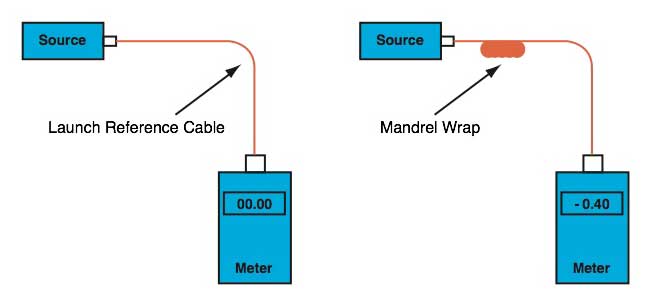
HOML is simple to use. Connect the launch reference cable to a source and measure the output of the reference cable with a power meter. Wrap the launch reference cable around the specified mandrel and measure the output again. If the measured power is reduced by 0.2 to 0.6 dB, the source is essentially EF compliant and ready to use, without the mandrel. Remove the mandrel and make your tests. If the HOML is >0.6dB, leave the mandrel on the reference launch cable and make measurements. If the HOML is <0.2dB, the source has too low a mode fill and should not be used.
More on HOML.
Data presented at the TIA meeting showed again that higher order mode loss (HOML) correlated well with encircled flux (EF) for all fiber types including 50/125 at 850nm. HOML shows promise of not only being a way to confirm the EF compliance of source/launch cable combinations but as a way for techs to "tune" their current sources.
HOML is an easy test to perform. Connect a reference test cable* to the source and zero the output. Install the mandrel wrap mode conditioner on the reference cable and measure the output again. There will be some loss which will vary according to the mode fill of the source/cable combination. If the loss you measure is within the range of 0.2 to 0.6dB, the source and reference cable are OK to use – they conform to EF limits.
"Link" and "Channel" Tests
ISO has come up with an ingenious method of testing the cable plant with equipment patchcords without including the connectors on the end. Why would you want to do this? Good question! In the standards committees, the copper people still dominate and they define a "link" and a "channel" differently, testing the channel without including the connectors on the ends of the connecting patchcords. This is forcing fiber into a copper model.
A link is what most fiber people would call the installed cable plant – the fiber optic subsystem (see FOA Standard FOA-6) that you connect equipment to with patchcords. The channel includes the patchcords that connect the equipment but not the connectors on the end that attach to the equipment.
While we are not experts on copper connections, we doubt the modular 8-pin connector has the same issues as a fiber connector, especially when connected to a transmitter or receiver. Since optical transmitters and receivers may use focused optics of various types or pigtailed, the quality of a fiber optic connector is vitally important and should not be ignored in testing.
For many years this has been discussed in network standards committees and most networks do not exclude the connectors on the end. Why the committee would even consider this option eludes us.
Accommodating Passive Optical Networks (PON)
The discussion about links vs. channels was a result of trying to figure out how to accommodate PONs in structured cabling standards. The issue is the passive splitter. Historically, structured cabling has excluded all passive optical devices like splitters or switches in the cabling, while interconnections (patching) is allowed. While that makes sense, it is not good for PONs which have a different architecture than most other networks that use structured cabling. FOA's argument is that TIA and ISO/IEC should separate cabling for PONs and add a new category of cabling similar to the way they have been working on Cat 8 for data centers. Cat 8 does not meet traditional structured cabling architecture, being point-to-point optimized for 40G in data centers. Why not do the same for PONs?
Fiber Specifications
In the FOA Guide, we have a page devoted to fiber specifications, where we try to list the relevant standards. While researching this, we determined that some of the US specifications do not correspond to international (G.xxx) specifications. Those standards are up for review and the aim to to resolve these differences.
More Information From OTDR Traces
OTDRs: Close inspection of Fresnel Reflections (Reflectance Peaks) May Yield Useful Information
by Terry O'Malley
When inspecting and analyzing Fresnels, particularly at the end of a system, testing technician should pay close attention to the trace of the recovery slope of all Fresnels, especially the end of system Fresnel. Sometimes it is possible to detect an upward, smaller spike in the recovery slope before the trace goes to the additional backscatter of fiber or into noise. This can often be attributed to a second “end of fiber” Fresnel close to the first Fresnel such as when a patch cord is connected to an end terminal or a cracked fiber is before or after a mechanical connection. A typical situation would be when the first Fresnel is generated by the fiber at the end terminal and the in the recovery there is a small upward point in the downward slope that can be the end of fiber in connected patch cord.
This can be responsible for having two different length measurements lengths from A to B and B to A for the same fiber. From one end the OTDR reads to the terminal Fresnel but does not read to the end of the patch cord and from the other end it reads distance through the patch cord. In this case the difference should be close to the length of the patch cord.
Caution: Some OTDR have anomalies in the software that erroneously produce faulty recovery slopes.
Actual traces demonstrating the information in a reflectance peak.
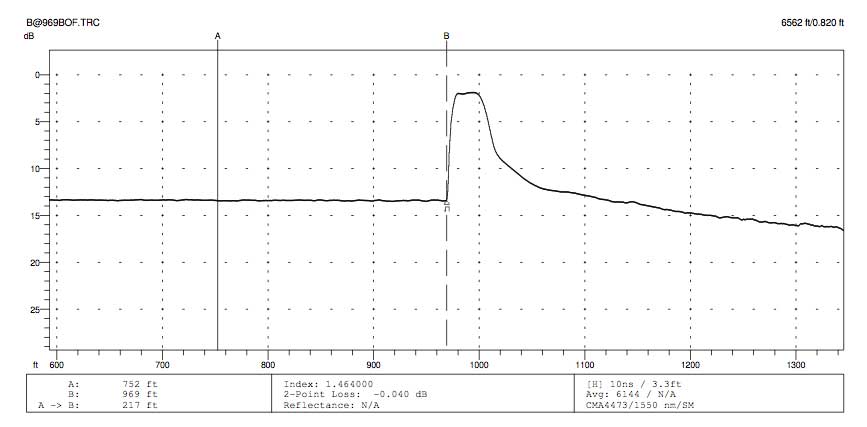
This is a trace of the end of a fiber. Note the structure in the reflectance peak.
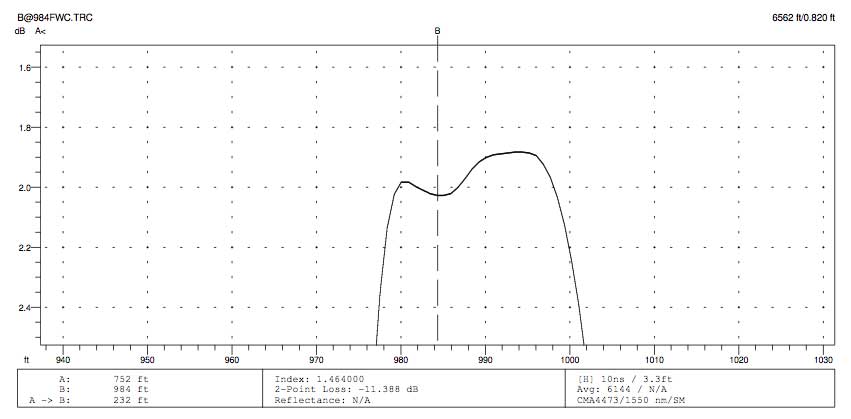
If you expand that peak, you can see structure in it. That is because the end of the cable has a 10m patchcord attached. It is too
short to be resolved by the OTDR, so the peak you see is the merger of two peaks separated by 10m. The drawing below shows
what happens when two events are too close for the OTDR to resolve.
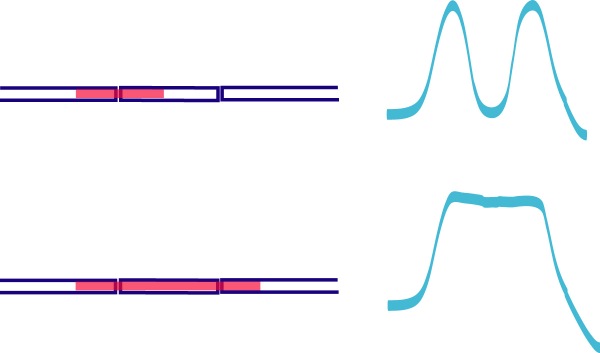
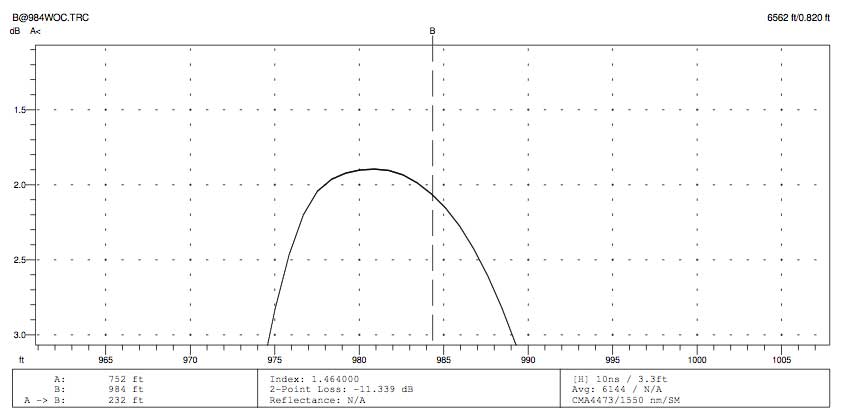
This is the same peak without the 10m patchcord. You can see there is no structure in the peak.
Good Practice Tools For OTDRs, All Free
FOA OTDR Simulator
You may already know that the FOA has a free OTDR Simulator you can download from our website (go here for directions) that allows you to practice using an OTDR on your PC, seeing the effects of changing setup parameters and analyzing dozens of real world traces. But here are two more tools that can be good for practice.
OTDR FAQs
Including more hints from FOA Master Instructor Terry O'Malley like tests on what the end of a fiber trace looks like with broken and cleaved fibers.
Frequently Asked Questions On OTDRS And Hints On Their Use
"Fiberizer" APP Reads, Analyzes OTDR Traces
Fiberizer is a iPhone/iPad APP that reads industry-standard ".sor" format files and allows trace analysis on your iPhone or iPad. An android version is in the works too. Read more about Fiberizer. And here are more directions on its use.
Facebook Offers New "Open Source" Data Center Switch
Facebook has taken networking into its own hands, building a switch to link servers inside its data centers, and wants to make the platform available to others.
The sprawling social network provider needs maximum flexibility to keep up with user growth and roll out new services, said Jay Parikh, the company's vice president of infrastructure engineering. He announced the switch, code-named Wedge, at the Gigaom Structure conference in San Francisco. Facebook had said in May of last year that it was working on a switch with the Open Compute Project (OCP).
The Wedge switch is being tested in Facebook's production environment and the company hopes to have it working in full production mode and released through OCP by the end of this year, said Najam Ahmad, Facebook's director of network engineering.
Networking is the final element of its infrastructure that Facebook is tackling by itself and through OCP, having already built servers and storage. Though few companies have the resources available within Facebook, ultimately making the switch design available through OCP could rock a networking industry that is still dominated by Cisco and a few other makers of specialized gear.
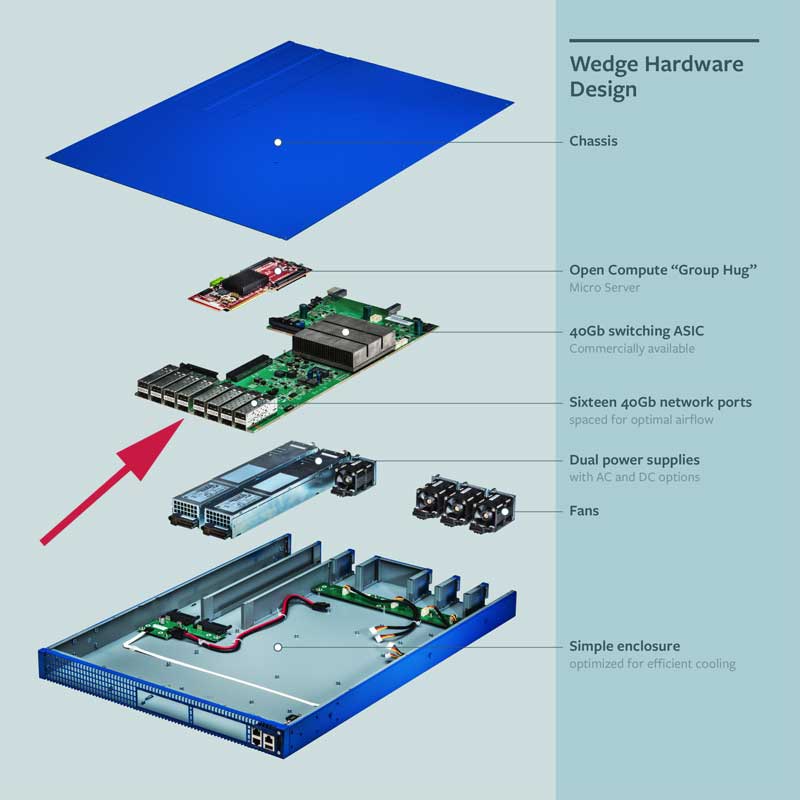
Photo from Facebook Engineering Blog. Note the pluggable 40G ports for various transceivers.
The Wedge switch is a "top of rack" switch, the kind built into each rack of servers in a data center to link those servers to the rest of the infrastructure. It has 16 40-Gigabit Ethernet ports and can be expanded to 32 ports, Parikh said. Facebook built its own chassis -- painted Facebook blue -- that is optimized for cooling and can have dual AC or DC power supplies.
A commercially available networking ASIC (application-specific integrated circuit) powers the switching functions. But the heart of the platform is a micro server based on the Open Compute Project's "Group Hug" design, Parikh said.
Separating the software and the hardware of networking platforms is one of the principles behind software-defined networking (SDN), which is being implemented across the networking industry in various standards-based and proprietary ways. Facebook went beyond that concept, separating the various components of the software as well as of the hardware in the switch. That gives developers more freedom to innovate in the future, Parikh said.
Read more: Facebook Engineering Blog.
FOA Now Offers Fiber Optic Textbook and Web Pages In Spanish (French coming soon)
Guía de Referencia de la Asociación de Fibra Óptica (FOA) Sobre Fibra Óptica
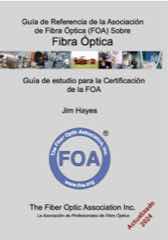
Guía de estudio para la certificación de la FOA
Este libro es una guía de diseño e instalación para redes de cableado con fibra óptica. Fue escrito como un libro de referencia para los instructores y estudiantes en clases para certificación CFOT FOA, así como una referencia para cualquiera que trabaje en el campo. Este libro ofrece una cobertura amplia de los componentes y procesos de fibra óptica que se utilizan en todas las aplicaciones y prácticas de instalación.
Disponible desde CreateSpace, Amazon.com y muchos otros libreros
Available from CreateSpace, Amazon.com and many other booksellers

Qué es la FOA (What Is The FOA, in Spanish )
Plus, FOA Now Offers Its Basic Fiber Optic Online Guide Website In Spanish
La guía básica de fibra óptica de la FOA ha sido traducida al español. Es la versión completa de la FOA Guía básica Online traducido por especialistas técnicos, incluyendo todos los dibujos. Por favor, lea o comprar una copia del libro impreso y nos dan su opinión sobre cómo podemos mejorarlo!
Léela aquí.
Si usted está enseñando a la fibra óptica, póngase en contacto con nosotros ya que estamos ahora traduciendo el programa de formación FOA CFOT también.
If you are teaching fiber optics, contact us as we are now translating the FOA CFOT training curriculum also.
OLANs - Optical LANs
New Free Fiber U Optical LAN (OLAN) Self-Study Program
FOA has added a new Fiber U self-study program on Optical LANs (OLANs). As you know, this is a hot topic in the IT world, so FOA has created an online course that allows you to study about OLANs (FOA includes fiber to the desk, fiber to the office and passive optical LANs) on your own time and schedule. You will be guided to material to read, videos to watch and even have quizzes to check your comprehension.
All Free!
OLANs on Fiber U
FOA OLAN Certification Released
OLANs are probably the most important new technology for enterprise networks since the introduction of structured cabling standards 22 years ago. For the last few months, FOA has been working with companies and groups interested in OLANs to create a certification for techs designing and installing them.
With OLANs, FOA has worked with leaders in the field to create technical materials on our FOA Guide website, Fiber U self-study program and YouTube channel already. We now have a curriculum ready our FOA-Approved schools which will make OLAN training available for those interested. Read More.
OLAN Resources
Over the last couple of years, we've written a lot about Optical LANs, either based on FTTH passive optical network (PON) or point-to-point (P2P) Ethernet architecture. The more we see of these types of networks, the more we appreciate their design and economy. But how about scale - how big can they get?
In November, we ran a picture story about the new San Diego Central Library which is using a Tellabs optical LAN using PON technology that was using about 1000 4 port drops. Now we hear another Tellabs customer has over 16,000 users. That must make it one of the biggest LANs in the world.
Here are more sources of information on optical LANs - BTW, they need a name - let's start calling them OLANs!
FOA Guide Page on OLANs and FOA YouTube Video
APOLAN, trade association for Optical LANs website http://www.apolanglobal.org/
RETURN TO INDEX
Events of Interest
Don't Miss These Seminars and Webinars:
~~~~~~~~~~~~~~~~~~~~~~~~~~~~

Successfully Deploy Fiber-Based Wireless Systems
Join EXFO's experts for this seminar that will use a combination of theory and practice to explore the best testing practices and methods for detecting issues during the construction and turn-up phases.
Topics for discussion include how to be more effective in the field by making better, more informed decisions. The concepts taught during this session cover the physical and service transport layers, and primarily apply to distributed antenna systems (DAS) and fiber-to-the-antenna (FTTA) deployments, but can also be applied to most short-distance fiber deployments.
Seminars are being held in locations around the US. April seminars are in NJ, NV and IL. Register here.
~~~~~~~~~~~~~~~~~~~

Passive Optical LANs - Now available for viewing on demand
By Patrick McLaughlin, Chief Editor. This webcast, produced and delivered by Cabling Installation & Maintenance, will go into depth on the practicalities of deploying a POL. In addition to discussing the technology’s history as a FTTH architecture and its applicability to enterprise environments today, the seminar will address considerations that must be made when an organization decides to implement a POL.
Register Here.
~~~~~~~~~~~~~~~~~~

Designing Secure Passive Optical LAN
Wednesday, April 16, 2014, 11:00:00 AM PDT - 12:00:00 PM PDT
Learn how to design Secure Passive Optical LAN architectures by adding optical network monitoring products and secure layer-one products. Secure PON delivers unparalleled performance and security.
Register here
~~~~~~~~~~~~~~~~~~

Lightwave Says "Passive Optical LANs Catch Fire*", Offers Free Webinar - WATCH ANYTIME
Here is the announcement and link to sign up.
With bandwidth demands on enterprise networks increasing, network managers have begun to rely more heavily on fiber. Passive optical local area networks (LANs) have emerged as a particularly strong option for building and campus applications as a future-proof way to meet very high bandwidths today or to ensure an smooth evolution toward future all-fiber enterprise networks.
This special webinar by Lightwave again confirms the rising popularity of Optical LANs (OLANs) based on FTTH technology and emphasizes the importance of the new FOA OLAN training and certification.
*If you are not fluent in English slang, that means it's "hot" or very popular!

See the Light® Fiber Optic Training Program
Webinars, seminars and certification training classes.

You are invited to join JDSU for a complimentary series of educational webinars. Each webinar, presented by a JDSU subject matter expert, lasts approximately one hour, including Q&A. Seminars are on Connectivity (May 23), Testing Fundamentals (June 20) and OTDRs (July 11)
Go here to see the seminars offered.
Don't forget to download your copies of the JDSU Testing Textbooks.
RETURN TO INDEX
 What's Happening @ FOA What's Happening @ FOA

FOA has three LinkedIn Groups
FOA - covers FOA, technology and jobs in the fiber optic marketplace
FOA Fiber Optic Training - open to all, covers fiber optic technology and training topics
FOA School Instructors - a closed group for instructors and administrators at FOA-approved schools
Grupo de La Asociación de Fibra Óptica FOA (Español)
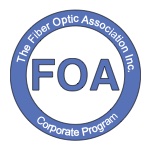 Corporate Memberships Corporate Memberships
FOA is now offering corporate memberships to companies involved in fiber optics as manufacturers, contractors, installers, etc. Corporate Membership gives companies discounts on memberships and direct certifications and access to special FOA materials for educating customers and employees. Read more.
FOA Standards:
FOA now offers free standards for datalinks and testing the installed fiber optic cable plant, patchcords and cable, optical power from transmitters or at receivers and OTDR testing.
What Is A Fiber Optic Cable Plant?
In a recent standards meeting, that issue was discussed with some disagreement as to what constituted a "cable plant." It seemed to be a perfect topic for another FOA "1Page Standard," so a draft version is now uploaded for review (FOA Standard FOA-6, Fiber Optic Cable Plant). Feel free to review it and comment to the FOA at info@thefoa.org.
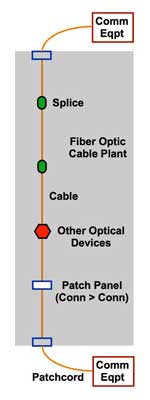
Available also is a new standard for Datalinks.
Look for the "1 PageStandard" web page and in the FOA Online Reference Guide.
Go to the FOA "1 Page Standards"
Free For FOA Members: NECA/FOA 301 Fiber Optic Installation Standard
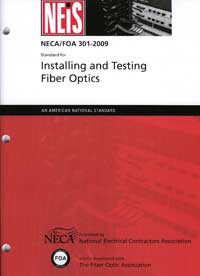
Standards cover components and systems and how to test them, but rarely get into installation issues. The FOA NECA 301 standard which covers installation of optical fiber systems has been revised for the second time, adding considerable new materials. This standard is derived from FOA educational material put in standards form and approved by ANSI as an American National Standard. It's specifically written to be used in contracts to define "installation in a neat and workmanlike manner." The standard is available from NECA. FOA members can go here for instructions on how to download your free copy.
RETURN TO INDEX
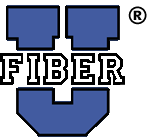
Free Fiber U Self-Study Programs
FOA'S "Fiber U" free online self-study programs help you learn about fiber optics, study for FOA certifications or use them to help create "blended learning" classes. There are two new free online self-study programs on Fiber U. Fiber Optic Network Design is for those interested in learning more about how to design fiber optic networks or studying for the CFOS/D certification. FTTx is for those wanting to know more about fiber to the "x" - curb, home, wireless, etc. - or studying for the CFOS/H certification.
Got to Fiber U for more information.
Lennie & Uncle Ted Now Available As Free Books on iTunes
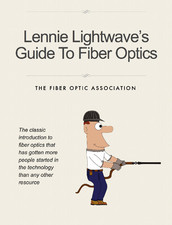 
Lennie Lightwave's Guide to Fiber Optics and Uncle Ted's Guide To Premises Cabling are now available free to iPad users who can download them from the Apple iTunes store.
Lennie's Guide has always been the world's favorite introduction to fiber optics. It was first published in the mid-1990s by Fotec, the fiber optic test equipment company famous for its "Fiber U" training conferences and more than 60,000 printed copies were distributed. Lennie was one of the earliest commercial webpages and is still online today (and as popular as ever) at http://lennielightwave.com. Uncle Ted's Guide was created at the request of Lennie readers who wanted a similar simple introduction to "Cat 5" wiring. This latest version of Uncle Ted's Guide covers the all premises cabling topics - wiring, fiber and wireless.
You can find these free guides on Apple's iTunes Store: Lennie Lightwave's Guide to Fiber Optics and Uncle Ted's Guide To Premises Cabling

FOA Now Offers Fiber Optic Textbook In Spanish
Guía de Referencia de la Asociación de Fibra Óptica (FOA) Sobre Fibra Óptica

- Reference Books for FOA Certifications available on Kindle and iPad/iPhone as well as printed
  
We have created three new FOA books to be used in training for FOA certifications and as reference books for contractors, installers and end users of fiber optics. These books have full curriculum support, including free curriculum materials for teaching FOA certification courses. Because we are self-publishing these books using more modern "publish on demand" technology, they are easier to keep up to date, easier to buy and much, MUCH cheaper!
All are now available in print and electronically in Kindle and Apple iBook versions. The basic fiber optic book is also available as a self-study program in an Apple APP for iPad/iPhone/iPod.
Details on the new book each of the new books are at the book pages linked to the photos above.
RETURN TO INDEX
FOA iPad Apps
The FOA has just released its second APP for the iPad, a free "loss budget calculator," FOA LossCalc.
FOA LossCalc
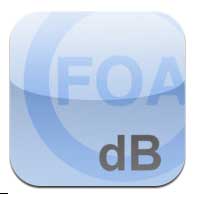 FOA LossCalc estimates the optical loss of a fiber optic link. This will save time for the installer of a fiber optic link needing to know whether test results are reasonable and/or make a "pass/fail" determination. It can also help the designer of a link to determine if communications equipment will operate over this link. FOA LossCalc estimates the optical loss of a fiber optic link. This will save time for the installer of a fiber optic link needing to know whether test results are reasonable and/or make a "pass/fail" determination. It can also help the designer of a link to determine if communications equipment will operate over this link.
By choosing the type of link (singlemode or multimode) and specifying the length of the fiber and numbers of connections and splices, it will calculate the end to end loss of the link. The app has default specifications for singlemode and multimode links or the user may create custom setups with specifications appropriate for any application. http://itunes.apple.com/us/app/foa-losscalc/id476262894?mt=8&ls=1
Self -Study in Fiber Optics
 Our first app is a self-study version of the FOA Reference Guide to Fiber Optics. The FOA APP builds on the FOA basic fiber optic textbook to create an interactive learning environment that builds on the iBook electronic version of the book to add a guide to use for self-study and real-time testing that provides feedback on what you have learned and correct answers to questions answered incorrectly. Our first app is a self-study version of the FOA Reference Guide to Fiber Optics. The FOA APP builds on the FOA basic fiber optic textbook to create an interactive learning environment that builds on the iBook electronic version of the book to add a guide to use for self-study and real-time testing that provides feedback on what you have learned and correct answers to questions answered incorrectly.
The FOA APP is priced at only $9.99, same as the iBook, so the self-study program is free. Download it from the Apple APP Store with your iPad or iTunes.
http://itunes.apple.com/us/app/foa-guide/id434354283?mt=8&ign-mpt=uo%3D4
More "Quickstart Guides"
In our continuing quest to help people understand how to test fiber optic cable plants and communications systems, we've created two more "QuickStart Guides to Fiber Optic Testing." They are simple, step-by-step guides on how to test fiber optic cable plants, patchcords or single cables using insertion loss or OTDR techniques and optical power from transceivers. It's as straightforward as it can get - what equipment do you need, what are the procedures for testing, options in implementing the test, measurement errors and documenting the results.
It can't get much simpler.
Send anybody you know who needs to know about fiber optic testing here to learn how it's done in a few minutes.
Testing Fiber Optic Cable Plants And Patchcords
Testing Fiber Optic Cable Plants With An OTDR
Measuring Optical Power In Communications Systems
RETURN TO INDEX

The FOA has many videos on  , including two Lecture Series (Fiber Optics and Premises Cabling), Hands-On lectures on both and some other informational and instructional videos. For all the videos, go to the FOA Channel "thefoainc" or use the direct links below. , including two Lecture Series (Fiber Optics and Premises Cabling), Hands-On lectures on both and some other informational and instructional videos. For all the videos, go to the FOA Channel "thefoainc" or use the direct links below.
New FOA Lectures And Hands-On Videos
How to Talk Fiber Optics - an introduction to fiber optic jargon.
Where Are The Jobs In Fiber Optics? FOA talks about all the applications for fiber optics, what jobs involve and the qualifications for the workers in the field.
What's A "Network"
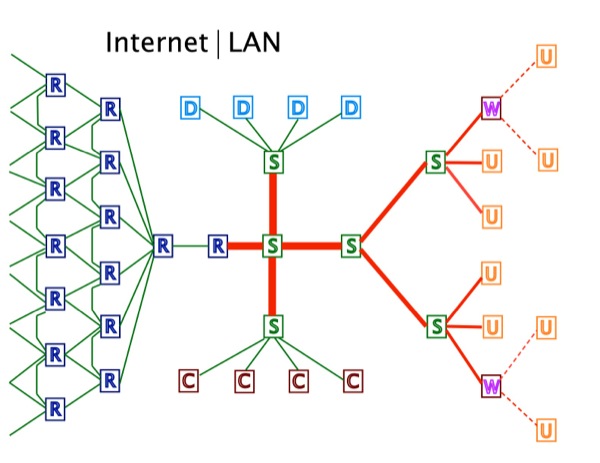
That's a common question from fiber and cabling people. Even though they may be installing the cable plants for networks, often the nature of networks is not something they have been exposed to, other than perhaps the catch-all "star network" description. But what is a network? What does it connect? How does it connect users and how does it allocate the bandwidth to them? How do various network types vary?
We've been working on some new YouTube videos on networks, starting as we usually do on a new subject with the basics. We have these three videos online now, but watch for more.
Fiber Optics - Live! A series of videos that use lab demonstrations to show how optical fiber works.
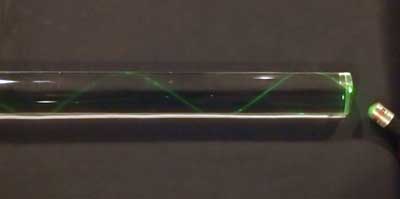
Prepolished/Splice Connector Termination (Panduit OptiCam)
Cabling Project Management - what's involved in a copper/fiber/wireless project -advice for the customer and the contractor
Hazards Of Counterfeit Cable
You may have read the stories we have written about the counterfeit "Cat 5" cable made from copper-clad aluminum rather than pure copper. Recently we tried an unscientific burn test on the cable compared to a known good UL tested cable and posted a video on YouTube. You can see the results below.
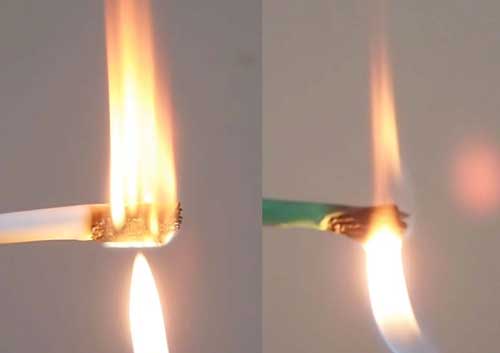
Counterfeit Cable Real UL-rated cable
The difference is obvious and the danger is real. Watch the video on YouTube: Premises Cabling Lecture 11: Counterfeit Cat 5 Cabling
View a complete list of FOA Videos with links to each video on YouTube.
View all the FOA Channel on YouTube.
RETURN TO INDEX

What's New in the FOA Online Fiber Optic Reference Guide?
We have been updating the Online Reference Guide to keep up with changes in the industry and adding lots of new pages of technical information.
Le Guide de référence pour la fibre optique de la FOA est maintenant disponible en français.
What do you do when you need to test fiber or cable on a reel? Here is a new page on Bare Fiber Testing
Couplers or splitters are used in FTTH and OLANs. How do you Test Splitters?
Tapping fiber has been a big topic in the news. How do you tap fiber?
The page on Optical LANs (OLANs) has been expanded with new material and links.
What's A Network? A simple explanation of network types and operation has been added to the FOA Online Guide.
We have updated the "Datalinks" page.
Three new "Quickstart Guides" for fiber optic testing: cable plant & patchcord loss, power and OTDR
Learn More About OTDRs - Download a Free OTDR Simulator
More and more installers are being asked for OTDR testing but using these instruments is not easy. They are hard to set up properly and complicated to interpret the traces. Using the autotest function can lead to disastrous results! The FOA has a good tutorial on OTDRs on our Online Reference Guide and we added a free download of an OTDR simulator to the OTDR section so you can learn how to use an OTDR on your PC.
More New Info:
Links to manufacturers and distributors of fiber optic lighting products.
The FOA Online Fiber Optic Reference Guide has become very popular - perhaps the most popular technical website ever, typically with over 360,000 users downloading about 1.75 million pages in 2011! We continue updating materials regularly, keeping it as up to date as possible.
Find What You Want Using "Google Custom Search
 There's so much information on the FOA Tech Topics and Online Fiber Optic Reference Guide that even a well-organized Table of Contents isn't enough and when the material is always changing, an index is impossible to maintain. So the FOA is using the latest technology in search, Google Custom Search, which will allow you to search just the FOA Tech Topics and Online Fiber Optic Reference Guide for any topic you want to find more about. Try it! There's so much information on the FOA Tech Topics and Online Fiber Optic Reference Guide that even a well-organized Table of Contents isn't enough and when the material is always changing, an index is impossible to maintain. So the FOA is using the latest technology in search, Google Custom Search, which will allow you to search just the FOA Tech Topics and Online Fiber Optic Reference Guide for any topic you want to find more about. Try it!
Go to The FOA Online Fiber Optic Reference Guide.
RETURN TO INDEX
New Schools
The FOA welcomes the newest additions to our listing of FOA-Approved Training Organizations:
North Seattle College
Seattle, WA
CFOT, FOA Approved School # 338
Find a listing of all the FOA-Approved schools here.
Find A FOA-Approved Training Organization

Most inqiries we get regarding finding a FOA-Approved training organization want to know two things: what school is closest to me or what school offers the certifications I need. The FOA has about 200 training organizations we have approved worldwide so finding the right one can be difficult! We've been looking at ways to make it easier, and we think we've got a good solution. In fact we have two solutions.
First we have added a sortable table of all the FOA-Approved schools.
You can also use our FOA Google Map Application to find FOA-Approved schools.
Here are links to the sortable table of all the FOA-Approved schools and FOA Google Map.
What Should A Fiber Optics or Cabling Tech Know and What Skills Do They Need?
FOA certifications are based on our KSAs - the Knowledge, Skills and Abilities that techs need to succeed. Read the FOA KSAs for fiber and cabling techs.
School News
We always enjoy feedback, especially when it shows how great some FOA instructors are. These came from students of Tom Rauch, an instructor at BDI Datalynk:
"I took your fiber optics certification courses this past March. I just wanted to let you know that in two weeks I start working as a fiber optic technician with ___ up in ___. You mentioned on the first day of the course that there is always one guy in class who had rubbed his last two nickels together to be there and, in that instance, I was that guy. Now I'm going to be able to provide for my family like never before and I owe it to the certification that I received from you and BDI Datalynk. I just wanted to thank you again."
"Thanks to our tremendously knowledgeable and patient instructor Thomas Rauch, who was not only generous in sharing his wealth of information, but he did so with ease, humor and in a way that invited curiosity and participation. He was encouraging and proud of our accomplishments and helped us learn from our mistakes in a way that did not break our confidence, rather it pushed us to better results the next go around. The hands on labs were just AWESOME!" Just thought you should know what a class act you have representing you in his travels..... but then again you probably already knew that! : )
In almost 19 years at Verizon and having held numerous positions, I have gone through many training sessions. I cannot remember ever having been actually looking forward to coming back to class quickly after lunch, to get back to the hands on activities, and walking away with the sense of empowerment that the information presented was not only relevant but dead on point accurate! I will be signing up for the Outside Plant class on March! I can't say enough good things about Tom and his impact! Feel free to quote me, I can only imagine that he will open so many doors and change so many lives in the years to come, with his style of teaching! Great experience, awesome job!"
IBEW and FOA Partner on Fiber Optic Training
The International Brotherhood of Electrical Workers (IBEW) and the National Electrical Contractors Association(NECA) through the National Joint Apprenticeship and Training Committee (NJATC) in a partnership with the FOA has published a new textbook for training IBEW apprentices and journeymen in fiber optics. The new textbook uses the material from the FOA Reference Guide To Fiber Optics with new material and photos from other NJATC training partners.
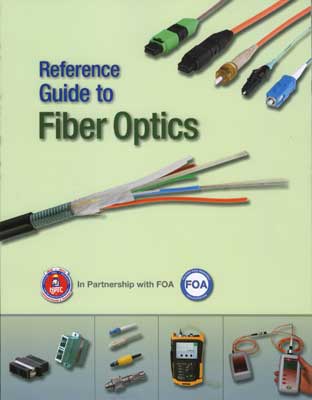
FOA is pleased to have been able to assist the NJATC in the development of this new text. FOA has been a NJATC training partner for many years, including offering instructor training at more than 16 of the NJATC's summer National Training Institutes. A majority of IBEW NECA contractors do fiber optics and low voltage, especially for applications that combine electrical and communications cabling like smart grid, alternative energy, traffic controls, data centers, etc.
Quote from one of our certified instructors: I want to thank you and your organization for all the resources you provide for the students and the opportunity to offer the certification to the students. The fact that you published the book yourself to get the cost down and the unlimited free resources on your website shows a commitment to the public that is second to none. I let it be known to the students that the FOA is the best in the industry at supplying knowledge and resources related to the communication industry. I look forward to passing on the information that you provide for the industry.
Great Video About An FOA School And Their Training
BDI Datalynk trains at the Unversity of Central Florida. UCF created this incredible video on the BDI Datalynk program. It shows the power of what they offer on campuses around the US.
Watch the video here: http://www.ce.ucf.edu/Program/2583/Fiber-Optics-Network-Certification-Courses-Non-credit/
For more information, contact Bob Ballard, CFOS/I, BDI DataLynk, LLC, A Vietnam Veteran-Owned Company
www.bdidatalynk.com, Ph: 512-785-9024
RETURN TO INDEX
Good Question! Tech Questions/Comments Worth Repeating
Real Questions From FOA Newsletter Readers
Singlemode or Multimode Connectors
Q: Can I use the same connectors for epoxy or anareobic terminations?
A: Connectors for singlemode and multimode fiber are different. SM connectors have tighter tolerances than multimode with slightly smaller hole in ferrule. Thus SM fiber should not be used with MM connectors because the tolerances will lead to core offset and higher loss. Likewise MM fiber might not fit in SM connector hole.
Cascading PON Splitters
Q: How does on design a PON or POL network with cascaded splitters?
A: The splitters can be placed where it makes sense or to save fiber, but the total split ratio of cascaded splitters should not exceed the maximum split ratio for the system standard, e.g. 64 for GPON (see the table here http://www.thefoa.org/tech/ref/appln/FTTH-PON.html).
The split ratios multiply, so if the maximum split is 64X, you can have:
64X only
32X and 2X = 64X (of course this is the same as 2X and 32X, if you are thinking the first splitter is nearer the OLT.)
16X and 4X = 64X
8X and 8X = 64X
Also, each system has a "Power Budget" (see http://www.thefoa.org/tech/lossbudg.htm) that is the minimum and maximum loss the system can tolerate over the cable plant. For the most popular versions of GPON, the power budget is 13dB minimum and 28dB maximum (so the cable plant, including splitters, between the OLT and ONT must have at least 13dB but no more than 28dB.) Within any given subsystem using one OLT port, you can have a different loss to each ONT (and you probably will) but the system will work as long as the loss in the link is between 13 and 28dB.
In addition, each system has a maximum number of ONTs that can be supported by the software, 64 in the GPON standard.
Encircled Flux Continues to Be A Problem (Update - see HOML article above)
Question from a installer: What’s the latest on encircled flux? We purchased some Flux encircled flux controllers at over $400 each. The warranty on those is only 90 days so they’re very expensive to replace, especially compared with the cost of new fiber jumpers. Do you know of a company that makes these besides ____? They don’t even service them and I have doubts about the quality. We’ve had problems with 2 that we never have had with fiber jumpers that we test with.
Answer: It's a long story, but....TIA is changing OFSTP-14 to only require EF on 50/125 Laser Optimized fibers at 850nm because it's unnecessary on other fibers and not proven worthwhile. Internationally, it's still called for everywhere, as far as I know. The only makers of those devices as far as we know is Arden Photonics in the UK. http://www.ardenphotonics.com/ The entire EF issue is based around products they alone make as far as we know. TIA knows the devices have a limited lifetime- the TR-42.11 committee has discussed the subject. The ISO/IEC committee behind it has said the old TIA mandrel wrap meets the EF standard. We quote the reference in our Guide page on EF.
FOA Loss Budget App
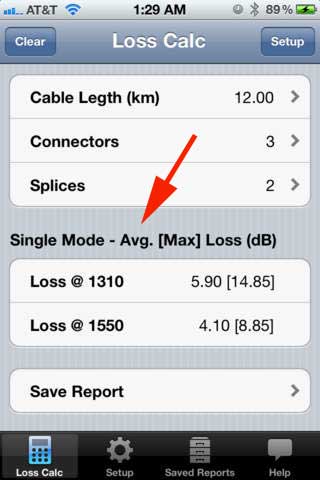
Q: How do you calculate the Avg loss?
A: The app is programmed to allow multiple setups of component loss values to ensure the values are appropriate to the application. There are default values for SM and MM using typical values (based on FOA experience) and max values (TIA or ISO/IEC standards which are worst case values decided ny manufacturers.)
When you create your own setup, you can set the typical (Splice Loss Typ) and maximum (just says Splice Loss for example) as you desire, so the app gives a range of loss values that will be what you expect (average or typical) and (Max) to compare against the Power Budget of the communication system when designing the cable plant and comparing against test results after installation. The "Help" section gives the values used in the default setups.
Polishing Pucks
Q: Why are there so many types of polishing pucks? Which ones are best?
A: Polishing pucks are available in more varieties than M&Ms - plastic, glass-fllled plastic, stainless steel, steel with carbide inserts, etc. We have used most types and find the inexpensive glass-filled plastic ones work fine. You need one for 2.5mm ferrule connectors (ST/SC/FC) and one for 1.25mm ferrule connectors (LC).
There are some caveats in using them that makes more difference than you think.
1. Polish on a flat plate topped with 1/8" (3mm) rubber of ~80 durometer on which the polishing film is placed.
2. Put the connector in the puck, place one side on the polishing film and gently lower it to the surface of the film to not damage the protruding fiber.
3. Calibrate your polishing pressure - it requires less than most people think. Watch this video from a couple of our instructors who used a postal scale to teach how much pressure to use: http://www.youtube.com/watch?v=vWEGBruEfG4
4. Clean the puck and polishing film after each use with a lint-free wipe and 99% isopropyl alcohol to remove the grit that accumulates - use the same cleaning wipes you use to clean the connector and dry it off, then clean the film and puck, then discard it.
Relative vs. Absolute Power Measurements
Q: I am thinking how to minimize uncertainty when doing relative measurements. I am mostly interested not in absolute power but rather a relative one, that is measuring loss not absolute power. Will any source of error be smaller or maybe vanish as a result of ratio? What can I do to reduce the uncertainty of the ratio of powers?
A: When measuring relative power, e.g. when measuring loss, the issue is relative power and depends on the linearity of the meter. The linearity of the meter can be affected by two issues - the slope of the calibration curve and the offset where the meter autoranges. Most meters read power over a large dynamic range, 1,000,000 to 1 (60dB) is not uncommon, and that is beyond the range of the electronics in the meter. To get this kind of range, the meters have a range switch controlled by the microprocessor that changes the gain in the amplifier attached to the detector. The amplifiers are linear and dB is calculated by the microprocessor so it does not matter if you measure in dB or W and calculate dB yourself. Calibration of the meter should include looking at the autoranging points to ensure minimal nonlinearity. Look at this graph:
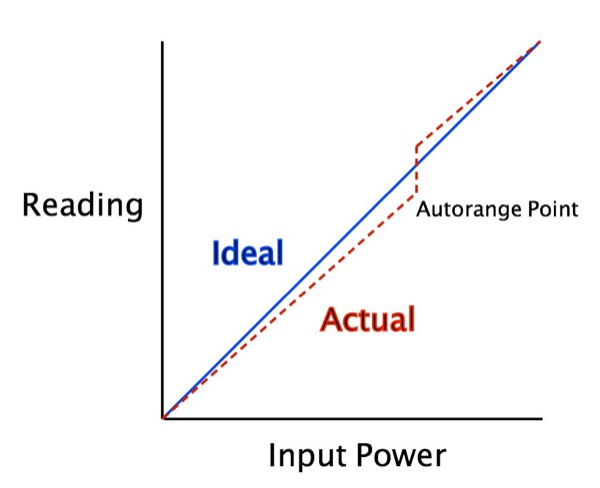
When the meter measures two power levels away from the autorange point, the error is simply the error in the calibration slope, which will be proportional to the range measured. For reading of a few dB, the error is usually very small, ~0.0x dB. If the measurement includes the autorange point, the error can be higher, depending on the amount of error in the autoranging.
This argues for having your meters calibrated by a factory-approved facility who knows where the autorange points are and can carefully calibrate around them. If you just check calibration at low and high points, you may miss autorange problems.
How to Clean POF (plastic optical fiber)
Q: I heard that plastic fibres such as PMMA can suffer damage from cleaning from an alcohol solution. Are there alternate cleaning solutions available for these types of fibres."
A: You can use a 10/90 mix of isopropyl alcohol/water. Typically use with a lint free swab. (from out POF consultants)
Using Older Fiber For Faster Systems
Question: My client has SMF 28 and Metrocor fiber cables that were manufactured c.2000. Please let me know whether these cables are obsolete or if they can be used for today's applications.
Answer: There is no definitive answer to your questions. The fiber may be used for upgraded systems but it must be tested for CD and PMD and results compared to the requirements of the systems being considered.
Testing Bare Fibers With OTDR
Q: We are starting to test some OPGW cables. We have an OTDR but we don’t find some reusable connectors. If we have to test an OPGW with 48 fibres, we can’t set up 48 SC connectors!
Are there some reusable connectors in the commerce?
A: I assume you mean you need to test with a bare fiber on the OPGW. For testing bare fiber, use a splice, not a connector. Have a long pigtail on the OTDR as a launch cable, long enough for the test pulse to settle, say 100-500m, then use a splice for a temporary connection. You can fusion splice the fibers then cut the splice out or use a removable splice like the Corning Camsplice (http://catalog.corning.com/opcomm/en-US/catalog/ProductDetails.aspx?cid=&pid=17929&vid=18219)
If you use a mechanical splice, you need a high quality cleaver just like with fusion splicing and after several uses, you need to add more index matching gel or liquid - mineral oil works OK. See the FOA page on Testing Bare Fiber.
Getting Started
Q: I have been asked internally what I would do and how I would start a data division. I know from looking at your website that you understand it and I was hoping you could give me some bullet points on how I would get a Tele/Data division started up from its infant stages. Any advice you could give me would be appreciated.
A: Basically, the cabling installation is similar to electrical, just the termination and splicing are different and testing is specialized. All these are easily learned. FOA has Fiber U free online training in both fiber and structured cabling (fiberu.org) and 80 YouTube Videos on this subject (FOA channel "thefoainc" you can use to become more familiar with the topics. Through the FOA we have approved schools that offer training and certification, courses you can take at scheduled locations or have brought to your facility.
OTDR Calibration
Q: I read on your website information about ODTR, and I'm curios if you could offer some more information. I am interested in all compatible standards considering OTDR Calibration. So far I managed to find out that there is IEC 61746-1 standard for Calibration, and also TIA/EIA-455-226 wich is adoption of IEC 61746-1. And I concluded that those 2 are surely internationally approved and do the same thing. I found in some website the offer for calibration performing both NIST traceable, and TIA 455.
I could not find out what is relation between TIA and NIST traceable calibration standards ( if there are any), is it the same or those 2 are compatible (if u use one of those for OTDR calibration it is enough)or those 2 are different and you need to perform both.
A: NIST was approached for OTDR calibration in the 1980s and considered making a transfer standard for use in calibrating OTDRs. It was intended to be a sample fiber of known index of refraction and length with splices and connectors of known loss. However the project was never completed as it could not be made agreeable to all parties. Many thought a calibration based on a device that would simulate the return from a cable was more accurate. Both these methods have been used since, but NIST never produced an OTDR calibration system like they did for optical power meters (I worked on that one myself.)
Other than the IEC document, I know of no other standards or traceable calibration by a national standards lab.
Is A Flashlight Test Adequate?
Q: I contracted a firm to install an OM3 of 200 meters. On one end I have an SFP 1000SX ,on the other a 1000SX converter from optical to UTP. We made pings but they never reached, and I didn’t see the laser at the extreme of the fiber. They promised me to send me the certification they supposely made ,though they assured me the fiber is ok, because WITH A FLASHLIGHT THEY SENT WHITE LIGHT FROM ONE SIDE TO THE OTHER AND IT WAS VISIBLE. I saw the light too, and I thought the culprit was my switch or my SFP. I want to know: is this a good demonstration that the fiber is ok?
A: A visual continuity test is not adequate - your eye is not calibrated! The power of the lamp is unimportant as each eye’s sensitivity is different. And your eye probably cannot see the light from a 850nm VCSEL source - most people’s eyes are not sensitive at that infrared wavelength. The installer should have tested the link with a light source and power meter (http://www.thefoa.org/tech/ref/testing/test/OFSTP-14.html) and given you the loss in dB. The connectors should also be inspected with a microscope to ensure proper polishing and cleanliness (http://www.thefoa.org/tech/ref/testing/test/scope.html). If the SFP output is -6dBm, what is the power at the receiver? 1000base-SX is supposed to work with 4.5dB loss (see http://www.thefoa.org/tech/Linkspec.htm). The fiber loss should be ~0.6 dB, so you must have >4dB connector losses! That says bad installation! The 1000SX link should work over 200m if the fiber has been properly installed.
Mismatched Fibers Working
Q: I have an existing light blue, 50 micron, armored fiber cable, with 3 pairs, between data closets. The first pair is used successfully with my 10 GB data network, using all 50 micron patch cables and connectors to Dell Force 10 switches.
My issue is with a secondary network. I would like to utilize a second pair on the 50 micron riser. But, the patch cables from each side will be 62.5 microns (orange) cables that go into my HP switches, with 1GB connectors. I know mixing 50 to 62.5 is NOT best practice according to your site (http://www.thefoa.org/tech/fib62-50.htm), but I have tested the connection from 1 HP switch to the other, utilizing the 62.5 micron patch cables, into the 50 micron uplink, with success.
Should this even be working? Is it strange that it works at all? If not, should I be even more concerned, if I connect 48 people using this same scenario?
A: This is a common problem. There is an explanation and two solutions.
Explanation: Every link has some margin for optical power - that is it has more power at the receiver than the minimum required. The link where you have Trans>62.5>50>62.5>receiver fiber will has a higher loss at the 62.5>50 connection near the transmitter and a lower loss (even than connections of two fibers the same size), since the larger fiber on the receiver end negates the losses due to most alignment factors - big to small means very low loss. Since the link works, the excess loss at the 62.5>50 connection near the transmitter is compensated by the lower loss of the 50>62.5 connection near the receiver and is within the original margin of the link. Thus it works.
Solution #1, document the mismatch and leave it alone - it works
Soution #2, replace the patchcords with 50/125 patchcords, since there may be a slightly lower coupled power from the transmitter, but not much since both are VCSELs* with similar power outputs, and the receiver will pick up all the light. In other words, using 50/125 patchcords will probably have higher margin.
* Since fiber networks moved to gigabit speeds, the old LEDs used at 100Mb/s were unable to cope, so everybody switched to an inexpensive laser a VCSEL - vertical cavity surface emitting laser - that launches power in a very narrow beam in the center of the fiber, smaller than a 50 micron core and way smaller than a 62.5 micron core. http://www.thefoa.org/tech/ref/appln/transceiver.html Thus there is no penalty to using the smaller fiber at the transmitter end.
We recommend you try #2.
Older Fiber?
Q: I have some 62.5 mm and sm inside fiber plant over 20 years old. When is a good time to upgrade?
A: When you need to or have to. If it's working OK, there is no need to upgrade!
"Connector Loss" or "Connection Loss"
Q: I have always counted the loss of a connector as .75 dB (568B-3) and 1.5 for a mated pair. Is that correct?
A: While the industry always says "connector" loss, it is actually "connection" loss. As we explain in the page on termination and splicing (http://www.thefoa.org/tech/ref/basic/term.html) When we say "connector" loss, we really mean "connection" loss - the loss of a mated pair of connectors, expressed in "dB." Thus, testing connectors requires mating them to reference connectors which must be high quality connectors themselves to not adversely affect the measured loss when mated to an unknown connector. This is an important point often not fully explained. In order to measure the loss of the connectors you must mate them to a similar, known good, connector. When a connector being tested is mated to several different connectors, it may have different losses, because those losses are dependent on the reference connector it is mated to."
The TIA spec of 0.75dB is for a mated pair of connectors. If you have been passing connectors tested @ 1.5dB loss....you may have some very bad connectors in your cabling!
Changing From OM2 to OM3/4 Fiber
Q: We have a system currently that is comprised of OM2 fibre with LED transceivers. There is a proposal to change the fibre to OM3 and I have been asked to look at how the change will affect the transceivers currently fitted which will remain the same until a later upgrade. From looking around on various forums I can see that OM3 is optimised for lasers, however the existing hardware will remain as LED. My understanding is that OM3 is simply fibre manufactured to a better standard than OM2 with significantly less internal defects. This leads me to think that switching from OM2 to OM3 fibre would not have any negative effect on the existing hardware and would probably reduce the overall link loss. I am also looking at whether we can use the same connectors, again looking on the internet I can see that the physical dimensions are the same, however are some connectors only certified to OM2?
A: The difference between OM2, OM3 and OM4 fiber is the "modal" bandwidth potential of the fiber at 850nm. OM2 and OM3 fiber is optimized for bandwidth with 850nm VCSELs and has no bandwidth advantage with 1300nm LEDs. The optimization is done by more careful manufacture of the graded index profile of the core of the fiber, nothing else. There is no reason to use OM3 or OM4 fiber with an LED transceiver as the LED cannot be modulated at high speed and the LED bandwidth in any of these fiber is limited by chromatic dispersion which is not significantly different in any of the higher grade fibers. The attenuation coefficient of these fibers is not enough different to justify replacement either. See http://www.thefoa.org/tech/ref/basic/fiber.html for more info on fiber. They all use the same connectors. Fiber optic connectors are not a factor in the bandwidth of the fiber.
Microscope Magnification (11/13)
Q: I am doing a lot of fiber optic jumpers for control systems, either single mode or multimode. I want to get a scope to inspect the ends after I clean them would you recommend a 200X, 400X handheld or one similar to a Noyes OFS 300 200C?
A: We prefer to use lower magnification and have a wider view so I can see more of the ferrule to determine its condition. You can see the fiber effectively at 100X but 200X may be better. 400X may be too much for most tasks like inspecting for cleanliness, but may be good if you are polishing SM for good reflectance. We've used the Westover units for years because they offer two different methods of illumination - direct and at an angle. If you are doing a lot of patchcords, I recommend a video microscope. I've used the Noyes unit that interfaces to a PC to create the FOA Microscope Inspection YouTube video here: http://www.youtube.com/watch?v=IyumH8CiUPQ&feature=youtu.be and it works well.
Recycling Cabling
Q: Who can I contact regarding recycling cable I am removing from a building?
A: Here are some people who say they recycle fiber optic cable or at least know how to do it:
http://www.scottrecycling.com/complete.html
http://www.scrapmonster.com/selloffer/fiber-optic-cable/10400
http://www.dnvkema.com/services/ces/hse/recycling/recycling-cables.aspx
http://tmscrapmetals.com/Recycling.html
Tech Hint: Did You Know You Have A Fiber Optic Tester In Your Pocket?
Yes! That old mobile phone has a camera which may be sensitive to infrared light - lots more than your eye - and can detect light in an optical fiber or from a transmitter. Chris Hillyer,CFOT/CFOS/I, Master Instructor, Northern California Sound & Communication JATC sent us some photos showing how this works. See below or the video now on YouTube. Update: You should check out your old cell phones before you recycle them. We've found older models use sensors which are better at infrared than the newer ones which take better pictures. This is a good use for your old cell phones hiding in the drawer!
Fiber Cleaning
This is a topic we keep reminding everybody about, and here is why:
From a contrator in the Middle East: Here some samples of the connectors for SM fiber already installed in the system we were testing.
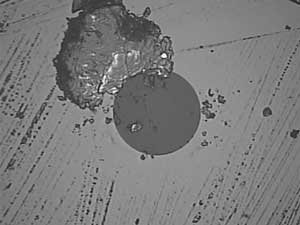 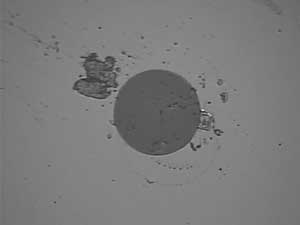
As you can see, the dirt is large compared to the size of the fiber (dark gray), and the core (not visible here) is only 9/125 of the overall diameter of the fiber! More on cleaning. See Product News below for links to vendors of fiber cleaning products.
See news about Fiber Optic Cleaning Videos on YouTube by ITW Chemtronics below.
Measurement Uncertainty: Everyone testing fiber optics should understand that every measurement has some uncertainty - whether you are measuring loss, length, wavelength, power, etc. Knowing that uncertainty is very important to interpreting the measurement. It's worthwhile to read and understand the issue of measurement accuracy covered in this page of the FOA Online Fiber Optic Reference Guide.
RETURN TO INDEX
Worth Reading or Watching:
What Is The FOA?
Hear FOA President Jim Hayes tell the FOA Story in a 2-part interview by Sound & Video Contractor Contributing Editor Bennett Liles. It tells about the FOA history, goals and achievements.
Part 1: http://svconline.com/podcasts/audio/fiber_optic_association_part1/index.html.
Part 2 http://svconline.com/podcasts/audio/inside-fiber-optic-association2-0924/index.html.
EXFO Poster For 100G Systems
EXFO's 100G reference poster, which provides a quick, yet comprehensive view of 100G line side modulation schemes and impairments. In addition, it can help you quickly grasp 40G/100G Ethernet (IEEE 802.3ba), OTU4/OTU3 (ITU-T G.709) and 40G/100G interfaces. You can view a PDF version of the poster here.
Where In The US Do Contractors Need Licenses For Fiber Optics?
We often get asked where in the US do contractors doing fiber optic installations need licenses. We found a good website for that information, the NECA -NEIS website. You might remember NECA-EIS, as they are the partner with the FOA in the NECA/FOA 301 Fiber Optic Installation Standard. NECA is the National Electrical Contractors Association and NEIS stands for National Electrical Installation Standards. They have a very easy to use map and table that gives you data on every state in the US, so mark these pages for future reference.
NECA/NEIS
http://www.neca-neis.org (See “State Regulations”)
http://www.neca-neis.org/state/index.cfm?fa=state_regs (all electrical licensing)
Low Voltage: http://www.neca-neis.org/state/index.cfm?fa=specialty_licensing
Fiber Support For Small Cells
Small cells are becoming very important for cellular coverage. Read this JDSU report published by Lightwave.
Networks Today: 80% on cable, 20% wireless, Networks Tomorrow: 20% on cable, 80% wireless
Dimension Data this week released its annual Network Barometer Report 2013, which evaluates the readiness of enterprise networks to support critical business operations. The announcement, made during the Cisco Live user conference in Orlando, Fla.

(The gentlemen looking at a bundle of copper cables must be illustrating the industry's nostalgia for old copper technology!)
You can download the Dimension Data report here.
How Is Fiber Manufactured?
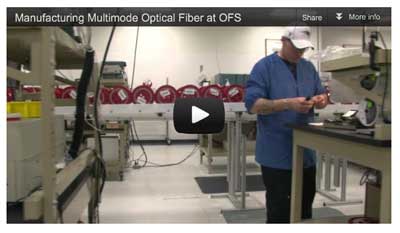
OFS invites you on a tour of their multimode fiber manufacturing facilities in this new 5-minute video. You will see their highly automated manufacturing operation in Sturbridge, Mass., including their patented MCVD preform fabrication process to fiber draw and final product testing. With a technological heritage dating back to AT&T and Bell Labs, OFS has been manufacturing high-quality multimode fiber since 1981.
Watch the video here.
Want To Know Where Submarine Fiber Optic Cables Run?
There is a good map online by TeleGeography you can access here.
Benchmarking Fusion Splicing And Selecting Singlemode Fiber
We've been asked many times "How long does it take to splice a cable?" It's not a simple answer as it varies with the number of fibers in the cable and the work setup, including whether one or two techs are working at a job site. FOA Master Instructor Joe Botha of Triple Play in South Africa did his own analysis based on decades of experience both splicing cables and teaching others how to do it properly. This is one of the best analyses we have seen because Joe includes prep times as well as splicing times and differentiates between one tech and two techs working together. He adds some other tips on fusion splicing too. This should be mandatory reading for every tech and given to every student! Here is Joe's splicing analysis.
Joe also has an excellent writeup on how to choose singlemode fiber that helps understanding the different types of G.6xx fiber. Read it here.
And you will want to read Joe's report on splicing different types of SM fiber, including bend-insensitive (G.657) fiber. Read it here.
Videos on Firestopping: These free videos from UL and the International Firestop Council are good tutorials on firestopping. Go here to view the videos.
Micro-Trenching, Cable Removal
Nano-Trench offers products for micro (or I guess they call it nano-) trenching and their website is very informative. They also have Kabel-X, a method of extracting copper cables from old conduit. Both websites are informative and interesting. Watch this video on the cable removal process!
Free - Mike Holt's Explanation Of The US National Electrical Code (NEC) For Communications Cables
Mike Holt is the acknowledged expert of the US National Electrical Code (NEC). His books and seminars are highly praised for their ability to make a very complicated standard (that is in fact Code - law - in most areas of the US) easily understood. Part of the appeal is Mike's great drawings that make understanding so much easier. Mike makes Chapter 8 of his book available free. It covers communications cables, telephones, LANs, CATV and CCTV, for premises applications. Even if you live in a region or country where the NEC is not the law, you may find this interesting.
Download Mike's Chapter Here.
Fiber Optic Cleaning Videos on YouTube
ITW Chemtronics has three fiber optic cleaning videos on  covering Dry Cleaning, Wet-Dry Method, FiberWash and Combination Cleaning. They are good explanations of cleaning processes - the Wet-Dry is especially interesting. covering Dry Cleaning, Wet-Dry Method, FiberWash and Combination Cleaning. They are good explanations of cleaning processes - the Wet-Dry is especially interesting.
- Westover Application Notes And Cleaning Video
- Westover has several application notes on inspecting and cleaning fiber optic connectors. The video is a big file (50+MB) but a good tutorial.
- Download page: http://www.westoverfiber.com/Support/downloads.php
-
A Documentary Treasure on the History of the Internet
15 minutes of a rarely-seen BBC documentary demolish the myth that ARPAnet was inspired by nuclear war, and explain the far more intriguing truth.
http://www.technologyreview.com/blog/mimssbits/26719/?nlid=4433
Ensuring Distance Accuracy On OTDR Measurements
By JDSU.
JDSU Reference Guide to Fiber Optic Testing
Volume 1 focuses on Basic Fiber testing and Volume 2 is geared toward fiber optic installers, project managers, telecom technicians and engineers who need to understand fiber networks. Volume 2 also covers Chromatic Dispersion, Polarization Mode Dispersion, Attenuation Profile and Fiber Link and Network Characterization. A 3rd volume, a glossary of fiber optic terms, is also available for download.
This is a "MUST HAVE" for all fiber optic techs. Download your free copies here.
We used this book as one of our references in creating a new page in the FOA Online Reference Guide on chromatic dispersion (CD) and polarization-mode dispersion (PMD).
-
- Download yourself a copy and read it!
-
Good Technical Website For Installers
American Polywater (http://www.polywater.com/) has one of the best technical website for cable installers. Check out their website, especially “Videos,” “Engineer’s Corner” and “Calculators.” http://www.polywater.com/NNNBSL.pdf
Fiber Optic Safety Poster
We've had numerous requests to reprint our guidelines on safety when working with fiber optics, so we have created a "Safety Poster" for you to print and post in your classroom, worksite, etc. We suggest giving a copy to every student and installer.
RETURN TO INDEX

" Heard on the Street" is a monthly online newsletter from Frank Bisbee of Communications Planning Corporation that covers the telecommunications and cabling businesses. Each month includes news from manufacturers, trade associations and professional societies like the FOA. You can read the current issue and back issues online.

JDSU has announced the See the Light webinar series, a four-part program designed for anyone involved in the installation, maintenance, and repair of fiber optic systems. It begins with fiber inspection and cleaning and then covers the basics of fiber testing. The webinar series then continues with the more advanced optical time-domain reflectometer (OTDR) and fiber local area network (LAN) testing challenges. More information on the series.
IGI is offering a series of webinars on topics of interest to those in the communications industry. You can join them live ir download from the archives. IGI WEBINAR ARCHIVES UP AND RUNNING - VISIT TELECOMBRIEFINGS.COM TO DOWNLOAD!
IGI, a major market research and technology reporting company (the "Active Optical Cables" below) is offering a a free one year subscription to one of our fiber optics newsletters to FOA members. All they have to do is to send IGI an e-mail stating which newsletter they would like to get. See http://www.igigroup.com/nl.html for a listing of IGI Newsletters.
RETURN TO INDEX
-
FOA Tech Topics -
A Fiber Optic Tester In Your Pocket? (See the video on  ) )
Yes! The camera in your cell phone is sensitive to infrared light - lots more than your eye - and can detect light in an optical fiber or from a transmitter. Chris Hillyer,CFOT/CFOS/I, Master Instructor, Northern California Sound & Communication JATC brought this to our attention.
 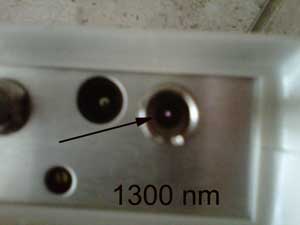
If you have an old cell phone, try it too. Our experience is that older cell phone cameras have better sensitivity at IR wavelengths than newer phones, so you may want to toss that old phone into the toolbox.
RETURN TO INDEX
Product News
A Really Bright Visual Fault Locator
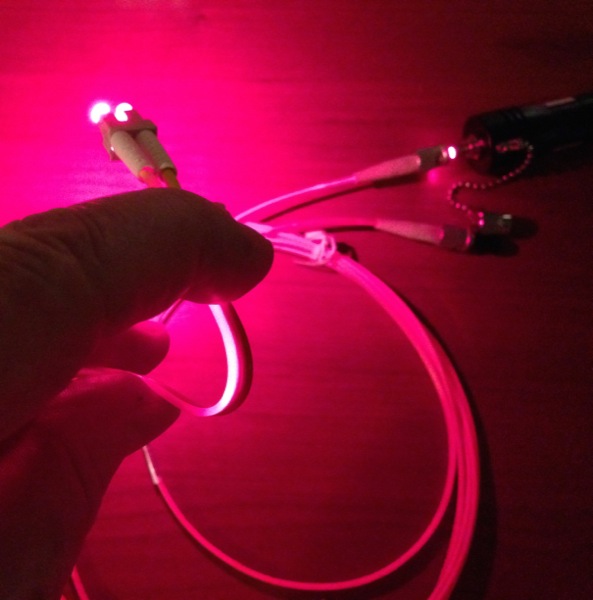
SKY Technologies recently sent us a VFL to evaluate. With a VFL, you need quite a bit of power to see splices and through some cable jackets, even MM orange (the cable in the photo) but especially other colors, so high power is an advantage. This VFL is the brightest we have seen - bright enough that you want to ensure it's aimed away from your eyes when you turn it on! It has CE and RoHS approval. Model FT650H-50B. Contact SKY for more information.
SKY Technologies Inc.
http://skytechlasers.com
http://visualfaultlocator.net
1.888.878.2374
Design Software for FTTH
At the recent FTTH Council meeting in Lafayette, Louisiana, we talked to Tim Barron, a consultant working with Network Design Decisions, Inc. (NDDI), a subsidiary of the global IT company Velankani Communications Technologies. NDDI provides a unique FTTx software capital planning tool called NOCPlan that allows the user to design, scope, and cost-out a new neighborhood or city-wide fiber project. It identifies demand points, optimizes where the OLTs, splitters, and fiber should be installed, generates a Bill of Material (BOM) and produces a total project cost for equipment and fiber construction.

According to Tim, “Many large service providers I typically talk to reveal that they still do this design work manually, and that what takes them a month to do could be accomplished in two or three days using NOCPlan.”
If you are designing a FTTH system, NOCplan might be worth consideration.
Tim Barron
tim.barron@att.net
or Kermit Ross
kermit.ross@nocplan.com
http://www.nocplan.com
Switch For Testing MTP/MPO Cables
Fibernext has introduced a portable switch for testing multifiber MTP/MPO connectors. You can also watch the YouTube video here.

Recycling Communications Cable
FOA was contacted by a company that recycles electronics communications equipment and cabling. CommuniCom recycles cable/metals/e-waste for Telcos and CATVs. They also recycle Fiber Optic Cable and associated Materials (the fiber scrap). And, they reclaim OSP abandoned copper cables (abandoned from road moves or FTTx growth). This is a huge part of our business. They do the work (permitting/locates/labor) for free and we revenue share back with our clients (telcos).
Contact Steve Maginnis
smaginnis@communicominc.com
www.communicominc.com
803.371.5436 (cell)

Micro-Trenching, Cable Removal
Nano-Trench offers products for micro (or I guess they call it nano-) trenching and their website is very informative. They also have Kabel-X, a method of extracting copper cables from old conduit. Both websites are informative and interesting. Watch this video on the cable removal process!
Protecting Pedestals From Rodents
Pedestals and underground vaults can be damaged by rodents who come up through the base and damage cables. Uraseal "Drain N'Seal" foam deters mice from taking up residence in your pedestals. They have some good videos on using their product.
Used Test Equipment – Buy or Sell
http://www.testequipmentconnection.com/
Have you read the FOA Tech Topics on Cleaning?
As much as 70% of the problems associated with deploying fiber result from something as simple as dirty connectors according to JDSU. Telephony Online.
US Conec's videos on cleaning fibers - show's the results of proper cleaning.
Westover
- AFL
ITW Chemtronics
Cleantex Alco Pads
MicroCare
Seiko-Giken
- RETURN TO INDEX
FTTH Notes:
Many States In the US Restrict Municipal Networks
As reported in the website "Community Broadband Networks," many municipalities are creating their own networks, including FTTH like Chattanooga and Clarksville, TN, etc. But in 19 of the US states, there are laws that handicap municipalities or outright ban their offering "telecom" services. (See the list of laws compiled by Optica here.) Obviously, these laws were passed to protect the (usually monopoly) telecom and CATV providers who do not want competition. But they also make it difficult or impossible for many areas to get broadband.
Does anybody know if these laws prohibit a municipality from building a fiber network and then leasing it to an Internet service provider? Obviously, FTTH needs good lawyers too.
-
FTTH in MDUs (Multiple Dwelling Units)
When we talk about FTTH, we often assume we are installing the fiber to a “home” where it terminates in a optical line terminal (OLT) and services (voice, data and video) are delivered inside the subscriber’s "home." But since we may have detached single-family homes, row houses or living units in a large building, the situations can be quite different, requiring different architectures and installation practices. To clarify the options for fiber in MDUs, FOA has created a new page in our FTTx section of the FOA Guide to explain the options.

FOA Guide: FTTH in MDUs
Testing FTTH
JDSU shows how to test a PON with an OTDR: http://www.jdsu.com/other-literature/PON-OTDR_fop_an_ae.pdf
-
- Want To Learn More About FTTx?
- The FOA has created a special FTTx resources section of our website with a FTTx links page with lots of links to news, market reports, technical articles and vendor technical and product information. Here is a great place to start learning more about FTTx.
- FOA's CFxT FTTx Certification Program Explained
- Read the Broadband Properties article about the FOA FTTx certification program. Read the article about FOA President Jim Hayes being honored for his work promoting FTTH.
|













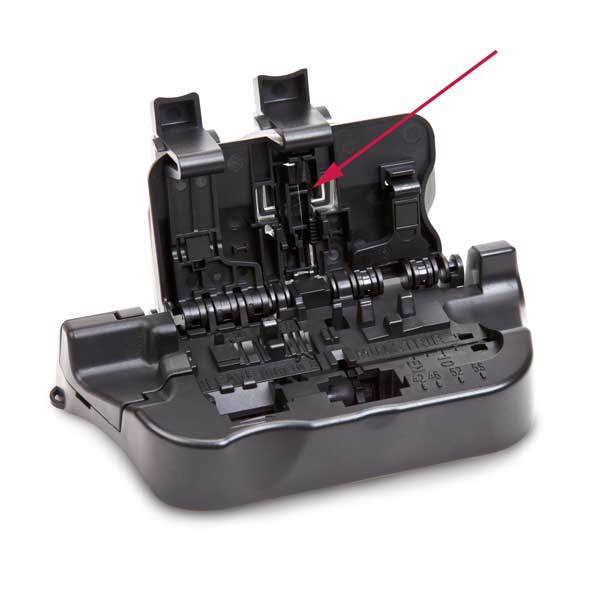
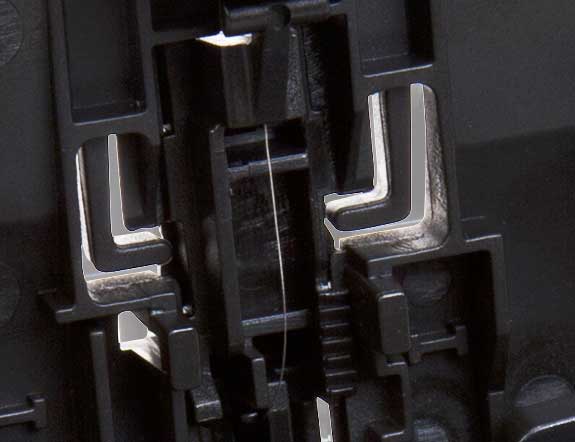
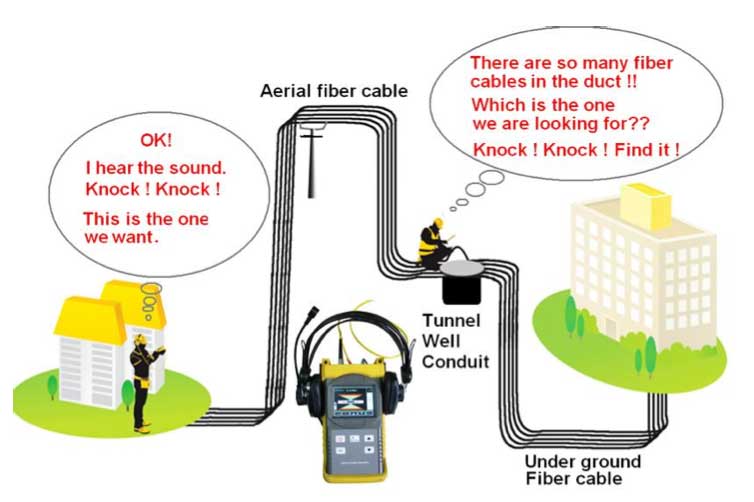














 What's Happening @ FOA
What's Happening @ FOA Corporate Memberships
Corporate Memberships

































